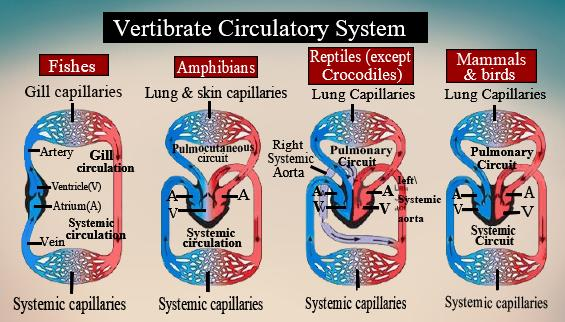
Assertion- Double circulation is incomplete in amphibians and reptiles.
Reason- Unlike in birds and mammals, in amphibians and reptiles, the left atrium receives oxygenated blood and the right atrium receives deoxygenated blood.
(a)Both Assertion and Reason are correct and Reason is the correct explanation for Assertion.
(b)Both Assertion and Reason are correct but Reason is not the correct explanation for Assertion.
(c)Assertion is correct but the reason is incorrect.
(d)Both Assertion and Reason are incorrect.
Answer
492.6k+ views
Hint: In most amphibians, the cardiovascular system is employed to move blood through the body. In these organisms, blood comes from two different routes and gets mixed in a single chamber.
Complete answer:
All Amphibians and reptiles (except the crocodiles) have a 3-chambered heart. It includes two atria and one ventricle, whereas crocodiles, birds, and mammals possess a 4-chambered heart which includes two atria and two ventricles.
In amphibians and reptiles, the left atrium of the heart receives oxygenated blood from the gills/lungs/skin and therefore the right atrium of the heart gets the deoxygenated blood from other body parts. However, they get involved within the single ventricle which radiates mixed blood (incomplete double circulation). That is why the Double circulation is incomplete in amphibians and reptiles.
In birds and mammals, oxygenated and deoxygenated blood received by the left and right atria respectively passes on to the ventricles of an equivalent side. The ventricles press it out with no mess up, i.e., two separate circulatory pathways are present in these organisms, hence, these animals have double circulation. Here the given reason is incorrect.
So, the correct answer is 'Assertion is correct but Reason is incorrect'
Note: Circulatory systems may be open (mixed with the interstitial fluid) or closed (separated from the interstitial fluid). Closed circulatory systems are characteristic of vertebrates. Fish have a two-chambered heart with unidirectional circulation.

Complete answer:
All Amphibians and reptiles (except the crocodiles) have a 3-chambered heart. It includes two atria and one ventricle, whereas crocodiles, birds, and mammals possess a 4-chambered heart which includes two atria and two ventricles.
In amphibians and reptiles, the left atrium of the heart receives oxygenated blood from the gills/lungs/skin and therefore the right atrium of the heart gets the deoxygenated blood from other body parts. However, they get involved within the single ventricle which radiates mixed blood (incomplete double circulation). That is why the Double circulation is incomplete in amphibians and reptiles.
In birds and mammals, oxygenated and deoxygenated blood received by the left and right atria respectively passes on to the ventricles of an equivalent side. The ventricles press it out with no mess up, i.e., two separate circulatory pathways are present in these organisms, hence, these animals have double circulation. Here the given reason is incorrect.
So, the correct answer is 'Assertion is correct but Reason is incorrect'
Note: Circulatory systems may be open (mixed with the interstitial fluid) or closed (separated from the interstitial fluid). Closed circulatory systems are characteristic of vertebrates. Fish have a two-chambered heart with unidirectional circulation.

Recently Updated Pages
Master Class 11 Economics: Engaging Questions & Answers for Success

Master Class 11 Business Studies: Engaging Questions & Answers for Success

Master Class 11 Accountancy: Engaging Questions & Answers for Success

Master Class 11 English: Engaging Questions & Answers for Success

Master Class 11 Computer Science: Engaging Questions & Answers for Success

Master Class 11 Maths: Engaging Questions & Answers for Success

Trending doubts
State and prove Bernoullis theorem class 11 physics CBSE

1 ton equals to A 100 kg B 1000 kg C 10 kg D 10000 class 11 physics CBSE

State the laws of reflection of light

One Metric ton is equal to kg A 10000 B 1000 C 100 class 11 physics CBSE

Difference Between Prokaryotic Cells and Eukaryotic Cells

1 Quintal is equal to a 110 kg b 10 kg c 100kg d 1000 class 11 physics CBSE




